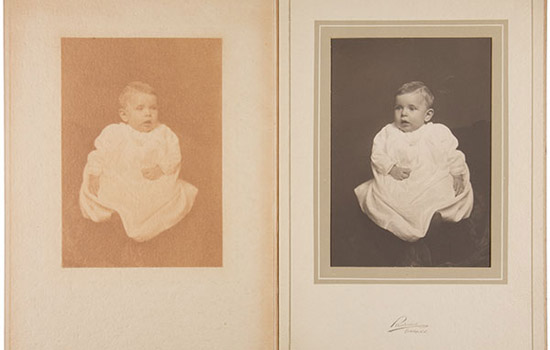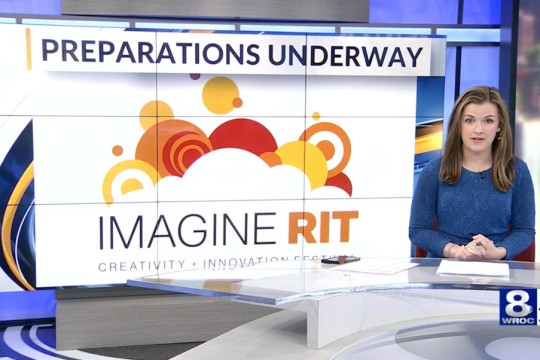Image Permanence Institute gets $500,000 grant
Institute will research and document photographic materials and processes of past three centuries
The above is a warm platinum print made circa 1900. Beginning in the late 1800s, it was common for commercial portrait studios to mount prints in a folder, such as this. The positive transfer image seen on the left was likely created by catalytic paper degradation caused by extended contact of the paper with metallic platinum.
To preserve photography of the past, the Image Permanence Institute at Rochester Institute of Technology has been awarded a $500,000 grant from the Andrew W. Mellon Foundation to collect, refine and disseminate information about the material nature of photographs in the 19th, 20th and 21st centuries.
As digital imaging becomes more popular, photography as a chemical technology using light-sensitive silver emulsions has nearly disappeared. With traditional photography fading, the firsthand experience of photography’s chemistry, processes and materials begins to vanish, too.
“The belief that the knowledge of the physical nature and material characteristics of photographs is and will remain vital to conservators, curators and historians is at the core of this three-year project,” says James Reilly, director of the Image Permanence Institute. “IPI has a long-term commitment to research and education about the materials and techniques of traditional photography. The project will build on this foundation and use IPI’s unique institutional setting, skills and knowledge to strengthen efforts toward creating a lasting resource to document, illustrate and preserve the legacy of photography.”
This project includes three primary activities—research and documentation of the material nature of photographic and photomechanical objects, outreach to current and potential audiences and internships for young professionals in the field of photographic preservation.
Sophisticated imaging techniques will be used to illustrate the physical characteristics and inherent qualities of photographic materials. Text will describe and explain the technical differences of the processes. Guidance will be given on how to identify the technique used to make a photograph, so that users can learn to distinguish one photographic process from another. This knowledge will be disseminated through the Image Permanence Institute’s online resource Catalog. The Graphics Atlas website provides a unique platform to study and examine photographic processes and is a valuable teaching tool for conservators, archivists and university educators.
Website content will be augmented and enhanced during this project, including the presentation and contextualization of the cultural and technological transition to digital imagery. The Image Permanence Institute is in a unique position to explain and illustrate the differences between traditional chemical images and modern digital technologies like inkjet because the IPI lab is at the forefront of research in digital printing materials. With Mellon Foundation support, IPI has undertaken a six-year study of digital hard copy print materials and the new preservation issues they present.
Project staff will undertake extensive outreach to current and potential audiences of the Graphics Atlas website in an effort to better understand their needs and help expand the site's audience and usefulness. Various user communities, including conservators, educators, curators and catalogers, have different needs, and it’s important to get input on how to make the resource useful and educational for them. The project includes a series of webinars designed for and advertised to those potential audiences and three workshops to be held in Rochester for professionals interested in learning about and contributing to the online resource.
Alice Carver-Kubik, photographic research scientist, and Alyssa Marzolf, imaging/microscopy technician, have been hired to work on this project. Carver-Kubik earned a Master of Arts in photographic preservation and collections management from Ryerson University in coordination with George Eastman House International Museum of Photography and Film, and a Bachelor of Arts in art history, photography and related media from Purdue University. Marzolf earned a Master of Fine Arts from Columbia College and a Bachelor of Fine Arts in professional photographic illustration from RIT.
Project funds will be used for two 15-month internships for professionals considering photographic conservation or related fields. The interns will assist in developing content for the website and preparation of outreach materials to extend its audience. Interns will gain a thorough knowledge of imaging techniques, the history and techniques of photographic processes, and the types and mechanisms of deterioration associated with each process.
About The Image Permanence Institute
The Image Permanence Institute, part of RIT’s College of Imaging Arts and Sciences, is a recognized world leader in the development and deployment of sustainable practices for the preservation of images and cultural property. The institute accomplishes this through a balanced program of research, education, products and services that meet the needs of individuals, companies and institutions.















